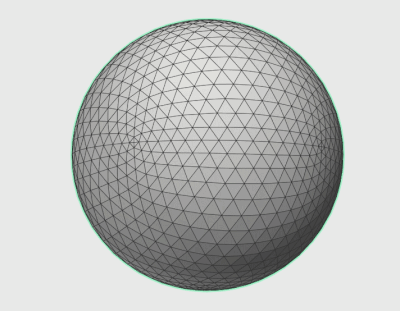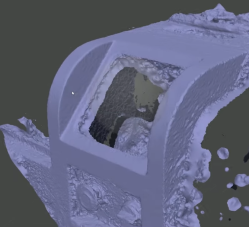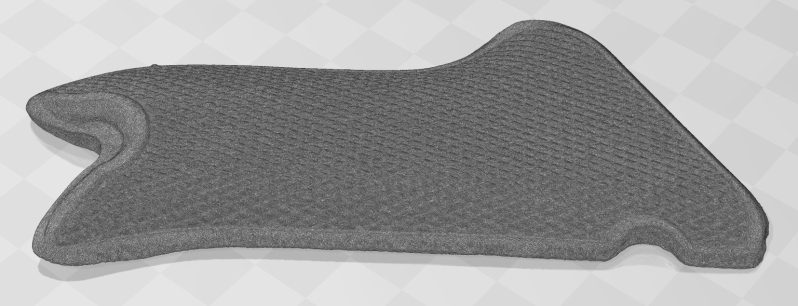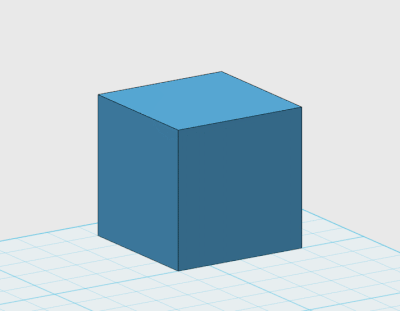3D scanning and 3D printing may sound like a natural match for one another, but they don’t always play together as easily and nicely as one would hope. I’ll explain what one can expect by highlighting three use cases the average hacker encounters, and how well they do (or don’t) work. With this, you’ll have a better idea of how 3D scanning can meet your part design and 3D printing needs.
How Well Some Things (Don’t) Work
Most 3D printing enthusiasts sooner or later become interested in whether 3D scanning can make their lives and projects easier. Here are a three different intersections of 3D scanning, 3D printing, and CAD along with a few words on how well each can be expected to work.
| Goal | Examples and Details | Does it work? |
|---|---|---|
| Use scans to make copies of an object. |
|
Mostly yes, but depends on the object |
| Make a CAD model from a source object. |
|
Not Really |
| Digitize inconvenient or troublesome shapes. |
|
Yes, but it depends |
In all of these cases, one wants a 3D model of an object, and that’s exactly what 3D scanning creates, so what’s the problem? The problem is that not all 3D models are alike and useful for the same things.
3D Scanning Makes Meshes, Not CAD Models
Broadly speaking, there are two kinds of 3D models: CAD models, and meshes. These can be thought of as being useful for engineering purposes and artistic purposes, respectively. Some readers may consider that a revolting oversimplification, but it is a helpful one to make a point about how 3D scanning, 3D printing, and CAD work do (and don’t) work together.
Hackers designing parts are typically most interested in CAD models, because these represent real-world objects that get modified in terms of real-world measurements. But 3D scanning will not create a CAD model; it will create a mesh.
Meshes can be used for engineering purposes — .stl files are meshes after all, and are practically synonymous with 3D printing — but a mesh cannot be modified in the the same ways a CAD file can. With a mesh, one does not extrude a face by a specific number of millimeters, nor does one fillet a corner to a specific radius. Meshes can absolutely be modified, but the tools and processes are different.
To sum up: 3D scanning makes 3D models from real-world objects, but the models that come out of the scanning process aren’t necessarily suitable for engineering purposes without additional work.
Options for the Home-based Hacker
At the beginning of this article I selected three typical intersections of 3D scanning, 3D printing, and CAD work to illustrate the various imperfect fits between them. Now I’ll go into those three use cases in more detail, and provide ways for the average hacker to use 3D scanning to make a project easier.
Using 3D Scanning to Create Copies
Photogrammetry is an accessible way to create 3D models, and free as well as paid options exist. Generally, the smaller and more complex an object, the harder it will be to obtain a result that preserves all the features and details.
Photogrammetry uses multiple photos of an object taken from a variety of different angles, and software interprets these photos to create a point cloud representing the surface of the object. A mesh 3D model representing the object can then be generated. Some cleanup or post-processing of the model is usually required, depending on the method and software.
-
- This blog post from Prusa Research walks through how to get the best results with Meshroom, a free option for 3D scanning using photogrammetry.
- OpenScan (and OpenScan Mini) is a DIY project by [Thomas Megel] aimed at using photogrammetry to scan small objects with high accuracy.
- RealityCapture is non-free software with a number of useful features and well-made tutorials. Notably, they have a license model option aimed at occasional use and small quantities. Since most software subscription models rarely make sense for hobbyists and one-off projects, it can be worth a look.
Creating a CAD Model from a 3D Scan
Since 3D scanning will not generate a CAD model, it’s not a direct alternative to designing a part in CAD. Most CAD programs allow importing a mesh, but the imported mesh remains a mesh, which cannot be modified in the same way as other CAD objects. It might be useful as a guide for a new design, however.

One may wonder if it is possible to convert from one format to another. It is, but the conversion may not be what one expects. Converting a CAD model into a mesh is simple enough, but converting a mesh into a CAD solid is less straightforward.
If a mesh is not too complex, it can be transformed into a solid (here is one way to do so by using MeshLab and FreeCAD) but it still won’t be a “normal” CAD object, and the image here demonstrates why.
If one’s goal is to use 3D scanning to make the creation of a CAD model easier and the conversion result shown here won’t do the trick, the next best thing is to use the 3D scan as a master and model a new part around it to match, using the imported mesh as a guide. One project that uses this approach is this custom trackball designed around a molded ergonomic prototype.
Some professional software suites have the ability to export to CAD, but the essential workflow is the same, with a scanned mesh being used as the reference for a new design.
3D Scanning to Digitize Inconvenient or Troublesome Shapes

Sometimes an accurate 3D model of a shape is needed, and that shape isn’t easily modeled or measured by hand. The same photogrammetry tools mentioned earlier are useful here, but their purpose is different. Instead of modeling the object from top to bottom to make an accurate copy, often only part of the object is needed.
For example, modeling the shape of an equipment panel or dashboard requires only the relevant section to be scanned successfully. A person’s head can be scanned to ensure a precise fit for a helmet or mask, and there’s no need to get a full scan of the entire body. In general, fewer pictures are needed and post-processing and model cleanup is easier because there is a smaller area of interest. A size reference must be included somehow for scaling later, because most 3D scans do not intrinsically create 1:1 models.
An excellent example of this approach is this project to design a custom control panel intended to fit an existing piece of equipment. Unlike when scanning a whole object with the intent of duplicating it, there’s no need to capture difficult-to-reach places like the bottom or back. This makes both scanning and model cleanup easier.
Professional Scanning
Another option is to pay for a professional scan. Fancy scanners and software suites costing thousands, or tens of thousands, of dollars and aimed at engineering applications exist, and while they are out of the reach of the average hacker, paying for a company to do a scan or two might not be.
Accuracy and resolution can be beyond what’s possible with photogrammetry, and some of the professional software suites have fancy features like aligning multiple scans, accurate size references, or the ability to generate CAD models based on scan results.

Shown here is the model of a part I had professionally scanned with a Creaform HandySCAN Black 3D scanner, according to my invoice. It is an old wood grip from an antique firearm. The scan still created a mesh, but it was an accurate 1:1 model of the original that I was able to use to print replacements on an SLA 3D printer.
When getting a quote for professional 3D scanning, be sure to ask about fee structure and be clear about your needs. In my case, it was cost-effective to scan multiple similar objects under a single setup fee.
Know What 3D Scanning Can (and Can’t) Do
3D scanning is getting better and more accessible all the time, but the fact that it generates a mesh means it doesn’t always fit smoothly into a 3D printing and CAD part design workflow. That doesn’t mean it can’t be useful, but it does mean that it’s important to know the limitations, and how they will affect your needs.
Of course, one can always dig out the calipers and manually model a part in CAD, but not all parts and shapes are easily measured or reverse-engineered. 3D scanning is a great alternative to modeling complex, real-world objects that would be impractical or error-prone to create by hand.
Have you successfully used 3D scanning to make a project easier, or have a favorite method or tool to share? We definitely want to hear all about it, so please take a moment to share with us in the comments.


















I’ve scanned things on a flatbed scanner -> svg –> CAD -> STL.
I was going to say, 2D scans are very useful for copying an object in CAD. In Fusion 360, import the scan bitmap as a “decal”, calibrate the size of the decal based on a measurement of the object, then use the decal image as a guide in creating the 3D shapes.
My first ever project to get featured on hackaday was a flatbed scanner based reproduction of a single layer PCB with a weird hard to measure external outline and a bunch of curved traces that served as contacts for a rotary switch. It worked pretty well.
I sold my xbox 360 while I was in middle school but kept the first generation Kinect.
It’s been very handy for a number of projects especially when I needed to digitize the complex geometry of a penny board deck. I suspended it and then walked around it and about 15min later I had a usable mesh as a reference.
Considering you can get them for 20 bucks now I’d say one is worth picking up just to mess with
Any good guides that you recommend?
Most of it was pretty intuitive. I used a free software called Skanect.
Attach an old pager vibrating motor to your Kinect…
For… Sensing objects in the dark?
Isn’t that only when your using multiple Kinects at the same time?
“3D scanning is getting better and more accessible all the time, but the fact that it generates a mesh means it doesn’t always fit smoothly into a 3D printing and CAD part design workflow. ”
I’ve been looking at doing that, but aside from the processing time it seems kind of finicky to get usable results.
https://store.steampowered.com/app/1202860/Sterio/
You forgot one important application, which is quality control. You compare the CAD model with the mesh to see where they differ and by how much. You might check if your print came out in correct dimensions, or see if some part you welded together came out twisted, and if so then how and where.
Suppose for example you were trying to build a CNC gantry and you wanted to check out how straight it is – well, make a model of it, decide where you want to place your coordinate reference, make a 3D scan of the real thing and then compare how much out of true it is by overlaying the two.
I think Rhino 7 can go from mesh to nurbs with an intermediate conversion to quads from triangles. Not cheap though.
I have been operating a 3d laser scanner for five years and have used multiple scanner brands and software for registering and modeling from the scans. This is amazing technology, but it seems like there has not been any significant leaps forward in quite a long time.
I run a scanning service and sales company. While this article is great at helping people understand the challenges that come with 3D scanning and creating CAD, there are some usable tools in Fusion 360 and a much better feature set in Geomagic’s Design X software. If you want to chat about scanning visit me at http://www.f3dscans.com
This totally goes along with what I worked on for my Masters! (Keep in mind that was a few years back now…)
I wanted an inexpensive way of scanning an object, and ending up with a 3D printable mesh. What I ended up doing was using an original Kinect sensor, and casting rays into a chunk of 3D space defined by an Octree. If three adjacent points “hit” something (i.e.: they didn’t have the max or min depth value), I’d treat them as a triangle, and intersect that triangle into the octree to mark the space as occupied. After scanning from a few different angles, I ran the contents of the octree through marching tetrahedrons, and converted it to a watertight 3D mesh. The resolution on the Kinect was the weakest point. It wasn’t great, but it was still pretty cool to think that I had built a very crude 3D photocopier.
I found this article really helpful, refresher on basics too.
I actually have a project that requires an accurate 3D scan and CAD model of a motorcycle gas tank, but I’ve put it off because I can’t guess at cost to do so, and have no idea who to send it to.
From mesh to cad. Maybe a challenge for IA?
To design and 3d-print the front bumper for my kit car I needed the complex curve of the body. Scanned with a Kinect and Skanect, simplified the mesh and imported into Fusion360. There I managed to model the plane with mesh section sketches applied an offset and used that to cut the bumper body. https://www.flickr.com/photos/152612378@N02/51133240504/
Nobody mentioned CMM ( coordinate measuring machine). It’s a CNC gantry with touch probe. Let’s you take precise measurements of key features, usually for quality control. Takes a while, but accuracy is normally that of the machine, one thousandth inch or better.